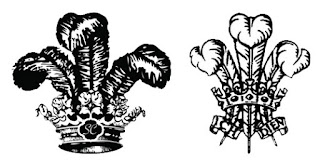Precedential No. 7: TTAB Affirms Section 2(b) Refusal of Mark Simulating the Prince of Wales Emblem
The TTAB affirmed a Section 2(b) refusal of the mark shown below left, for various goods in classes 20, 21, and 24, including furniture, dinnerware, and fabrics, on the ground that the mark comprises a design that simulates a governmental insignia of the United Kingdom, namely, the Prince of Wales' emblem (shown below right). In re Shabby Chic Brands LLC, 122 USPQ2d 1139 (TTAB 2017) [precedential] (Opinion by Judge Shaw).
Section 2(b) bars registration of a mark that "[c]onsists of or comprises the flag or coat of arms or other insignia ... of any foreign nation, or any simulation thereof." Thus the issue before the Board involved two questions: (1) Is the Prince of Wales' emblem an insignia of a foreign nation; and (2) if so, does the applied-for mark consist of or comprise that insignia, or a simulation thereof?
Insignia?: The Prince of Wales is a member of the British royal family and is heir to the throne. The emblem at issue here has a long association with the Prince of Wales; its use dates back to the 14th Century. The Government of the United Kingdom identified the emblem as "[t]he official emblem of the Prince of Wales" when it notified WIPO in 2005, under the Paris Convention, that this emblem is a 'state emblem' of the United Kingdom. WIPO transmitted this notification to the USPTO pursuant to Article 6ter of the Paris Convention.
The United States has implemented its obligations under Article 6ter, in part, through Section 2(b) of the Trademark Act. The USPTO assigned the emblem a serial number specifically identifying the entry as "non-registration data" and it entered that data into the USPTO search database, to assist examining attorneys when considering possible statutory refusals. This item in the database is not a registration and thus not a basis for a Section 2(d) refusal, but it may form the basis of a Section 2(a) or 2(b) refusal.
The Board concluded that the Prince of Wales' emblem is an "insignia of national authority" on a par with a coat of arms, as found in Section 2(b), and therefore that the emblem qualifies as an insignia of a foreign nation.
Simulation?: Because of the differences between the applied-for mark and the emblem, the Board found that the mark does not consist of, or comprise, the emblem. In determining whether the mark is a "simulation" of the emblem, the Board must consider the "first impression gathered from a view of such mark without a careful analysis and side-by-side comparison ...." In re Advance Indus. Sec., Inc., 194 USPQ 344, 346 (TTAB 1977).
The Board noted several differences, including the banner and wording "Ich Dien," which are missing from applicant's mark. In contrast, the latter includes the initials SC in front of the shield. Also, the quill ends of the feathers are not visible below the crown in applicant's mark, the crowns are slightly different in design, and the feathers are arranged somewhat differently. Nonetheless, the similarities in their commercial impressions outweigh these differences.
[B]oth Applicant’s mark and the Prince of Wales’ emblem create the same overall impression, that of a heraldic crown with three large feathers extending up from the crown. In addition, given the fact that some variation in the representation of the Prince of Wales’ emblem is permitted, it is possible that consumers viewing Applicant’s mark would ascribe any differences between Applicant’s mark and the emblem to such permitted variation.
The Board therefore found that the applied-for mark is a simulation of an insignia of a foreign nation, namely, the Prince of Wales' emblem.
Applicant argued that it is unlikely that customers will believe that the applied-for mark has any association or connection with the Prince of Wales. The Board pointed out, however, that the Prince is able to grant Royal Warrants of appointment to companies, who may then display "The Prince of Wales' Feathers" on their products. Therefore consumers might possible believe that applicant has been granted such a Royal Warrant.
Applicant also asserted that its mark has co-existed with the Prince of Wales' emblem for 13 years without objection or confusion, but the Board pointed out that absence of objection or confusion is irrelevant, since Section 2(b) is an absolute bar, and confusion plays no part in the analysis.
Finally, applicant pointed to two now-cancelled registrations that it owned for nearly identical marks, arguing that it is illogical to deny registration here. The Board pointed out, once again, that each application must be considered on its own merits, and the Board is not bound by the decisions of examining attorneys in other cases. Moreover, the Board noted, the marks in the two prior registrations were examined in 2003, before the Prince of Wales' emblem was claimed and recorded as a state emblem.
And so the Board affirmed the refusal to register.
Read comments and post your comment here.
TTABlog comment: Do you think the applied-for mark was inspired by the Prince's emblem?
Text Copyright John L. Welch 2017.





3 Comments:
Sure, it was inspired by the Prince's emblem, but since when do Americans give any clout to royalty?
Constitution Article I, Section 9, clause 8: No Title of Nobility shall be granted by the United States.
Isn't that exactly what the TTAB has done?
Congress enacted Section 2(b). The TTAB just interprets and enforces it. I don't think this law amounts to the granting of a title of nobility to anyone.
I'm only just reading this opinion now -- but I never knew that there was material in the USPTO database that's "non-registration data," like the Prince of Wales emblem. I found 750 with the term "6ter" in the "Other Data" field on TESS. The most recent seems to be from 2014: PAN AMERICAN CENTER FOR FOOT AND MOUTH DISEASE. Pretty interesting stuff.
Post a Comment
<< Home